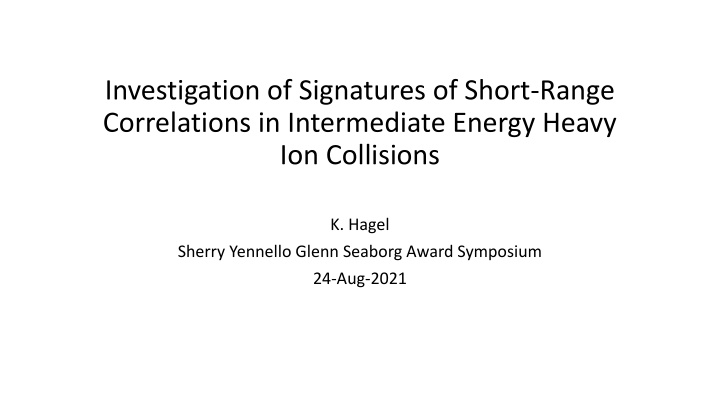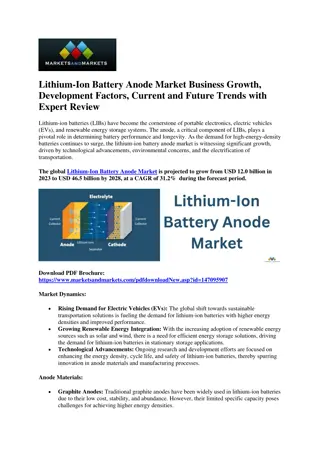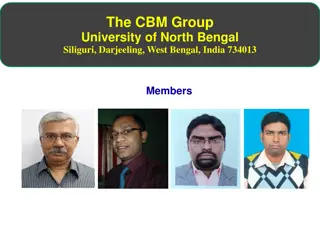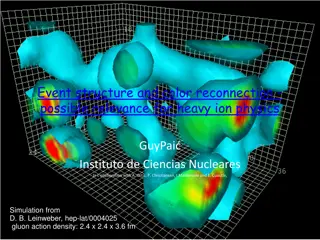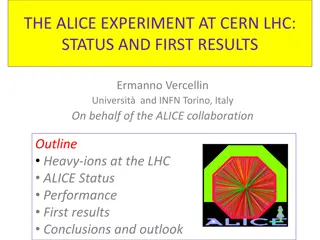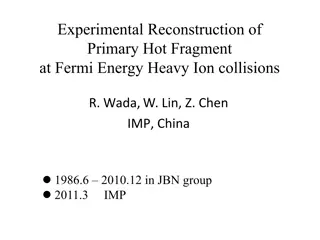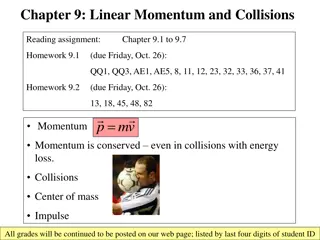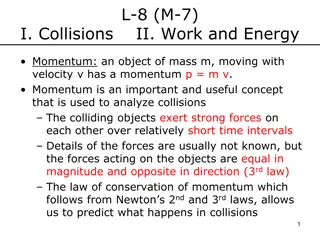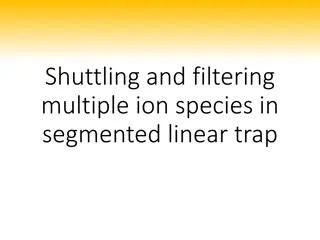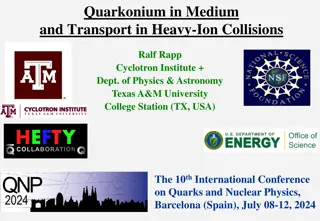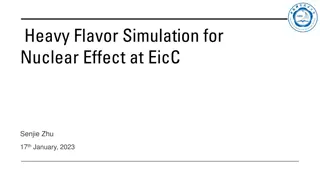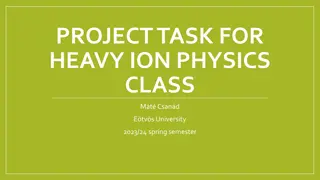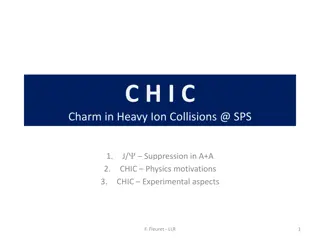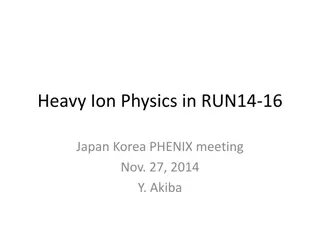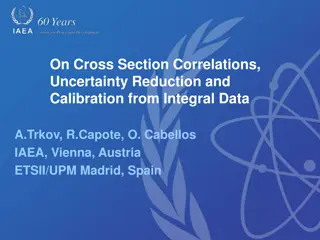Investigation of Short-Range Correlations in Heavy Ion Collisions
Short-range correlations in nuclei play a crucial role in understanding the properties of nuclear wave functions and the transition from baryonic to quark-gluon degrees of freedom. Early theoretical work emphasized the importance of short-range correlations, particularly in modeling the nucleon spectral function. These interactions have universal features and impact the momentum distribution in neutron-rich nuclei. Recent studies have shed light on the dynamics of the nuclear repulsive core and the hidden color states inherent to QCD dynamics.
Download Presentation

Please find below an Image/Link to download the presentation.
The content on the website is provided AS IS for your information and personal use only. It may not be sold, licensed, or shared on other websites without obtaining consent from the author.If you encounter any issues during the download, it is possible that the publisher has removed the file from their server.
You are allowed to download the files provided on this website for personal or commercial use, subject to the condition that they are used lawfully. All files are the property of their respective owners.
The content on the website is provided AS IS for your information and personal use only. It may not be sold, licensed, or shared on other websites without obtaining consent from the author.
E N D
Presentation Transcript
Investigation of Signatures of Short-Range Correlations in Intermediate Energy Heavy Ion Collisions K. Hagel Sherry Yennello Glenn Seaborg Award Symposium 24-Aug-2021
Short Range Correlations in Nuclei Fluctuations when nucleons form pairs with high relative momentum and small center of mass momentum for short periods of time. Important in the investigation of large relative momentum and short distance ( 1.2 fm) properties of nuclear wave functions Domain of transition from baryonic to quark gluon degrees of freedom New phenomena inherent to QCD dynamics that are not visible to long-range nuclear forces. Chiral symmetry, quark interchanges, gluon dynamics, and hidden color states, among others. Dynamics of the nuclear repulsive core Practically unexplored Short Range Correlations ~Rnucleon Long Range Correlations ~Rnucleus Momentum space p1 Coordinate space 2N (np)- SRC p2 p1>pF ~1fm p2>pF Ann. Rev. Nucl. Part. Sci. 67, 129 (2017)
Early theoretical work Importance of Short Range Correlations first emphasized by Jastrow (Phys. Rev. 98, 1479 (1955)). Variational methods to estimate upper limit of the ground-state energy fails for the strong interaction Range comparable with the size of the nucleon, r0. Added NN correlations at r r0 Dilute nucleon gas Calculate momentum distribution at zero temperature of a dilute Fermi gas with repulsive interactions Simple model of a dilute nucleon gas yields 1/k4 dependence for k>kF 2 3 1 W. Czyz and K. Gottfried, Nucl. Phys. 21, 676 (1961) k/kF
Early theoretical work Modeling the nucleon spectral function Describes basic two-nucleon configurations generating the structure of the nucleon spectral function at high values of the nucleon momentum Decomposed into n(k) = n0(k) + n1(k) n0(k): single particle features of nuclear structure n1(k): short range properties of nuclear structure At k > kF, short range properties dominate production C. Ciofi degli Atti and S. Simula, PRC 53, 1689 (1996)
Properties of short range interactions Universal feature of short-range interaction Probability of fermion to have k>kF larger for minority (protons in case of neutron rich nuclei) than majority Short range interaction populates high k tail with equal majority and minority fermions Larger fraction of majority fermions in low k states. np-pair dominance causes a greater fraction of protons than neutrons to have high momentum in neutron-rich nuclei M. Duer, O. Hen, et al., Nature 560, 617 (2018). O. Hen, et al., Science 346, 6209 (2014).
Observing Short Range Correlations Pickup reactions, stripping, and electron and proton scattering Typically done using high energy beams 5.014-GeV electron beam incident on 12C, 27Al, 56Fe, and 208Pb targets CLAS at Jefferson Lab Electron-induced two-proton knockout reactions 5.9, 8.0 and 9.0 GeV/c p + 12C Can SRC be observed in intermediate energy Heavy Ion Reactions? Science 346, 6209 (2014). Phys. Rev. Lett. 90, 042301 (2003)
Evidence for SRC in Intermediate HI collisions Theoretical study of the interplay between SRC and symmetry energy. In the whole energy range of photons, effects of the SRC overwhelm those owing to the Esym( ). Calculated at 45 MeV/u Ca + 112Sn Hard photons Do not suffer from final state interactions G.-C. Yong and B. A. Li, Phys. Rev. C 96, 064614 (2017)
Can particle spectra from intermediate energy heavy ion reactions carry information on Short Range Correlations? 44 MeV/u Ar + V Proton energy spectra extend to more than twice the kinematic limit of first chance N-N collision Presence of high momentum tails? 14o 83o 158o R. Coniglione et al., Phys. Lett. B 471, 339 (2000)
Experiment Experiment Beam Energy: 47 MeV/u Reactions: 4He, 10B, 20Ne, 40Ar, 64Zn + 112,124Sn Reactions: 4He, 10B, 20Ne, 40Ar, 64Zn + 112,124Sn Beam Energy: 47 MeV/u NIMROD NIMROD 14 Concentric Rings 3.6-167 degrees Silicon Coverage Neutron Ball Neutron Ball 14 Concentric Rings 3.6-167 degrees Silicon Coverage Focus on protons detected at the most forward ring ( ~ 4.3o) beam 9 9 S. Wuenschel et al., Nucl. Instrum. Methods. A604, 578 583 (2009).
Proton spectra at = 4.3o PLF source T set to 4 MeV Data enhanced at high energies relative to fit Transform Energy spectra to wavenumber (k = p/ ) in PLF frame vsource = vp
t/3He (n/p) are proton rich at large k Below 1 for k > ~.1 - .3 fm-1 (in projectile frame) Consistent with a greater fraction of protons than neutrons to have high momentum in neutron-rich nuclei
Proton k spectra (projectile frame) k4d2M/d dk levels off for k > 0.8 fm-1 Consistent with 1/k4 dependence Fit is consistent (as it must be) 64Zn distribution may begin to fall faster than 1/k4 at k > 1.1fm4
SRC Intensity Increases with mass of projectile Levels off for 64Zn Effect of larger mass?
Conclusions Proton distributions consistent with 1/k4 dependence at large k Intensity increases with projectile mass Evidence for SRC from protons in 47 MeV/u heavy ion collisions Outlook Gamma ray experiment
Collaborators J. B. Natowitz, L. Qin, R. Wada, K. Hagel, Z. Chen, M. Huang, J. Wang, S. Kowalski, M. Barbui, D. Fabris, M. Lunardon, S. Moretto, G. Nebbia, S. Pesente, V. Rizzi, G. Viesti, M. Cinausero, G. Prete, T. Keutgen, Y. El Masri, Z. Majka, and Y. G. Ma,
k-4 scaling of momentum dependence of SRC nuclear-mass dependence of the number of SRC pp and pn pairs in nuclei can be described by tensor operators acting on NN pairs in a nodeless relative S state of the mean-field basis. This very-short-range behavior of the correlated part of the NN interaction leads to k 4 momentum dependence at high momentum Arises from the importance of the one-pion-exchange (OPE) contribution to the tensor potential VT , acting in second order. ?00?,? ?16?4 4?4 ?2??? ?? + ?2?02(?,?)?20(?,? )~????? Signature of short range interaction Necessary and sufficient condition for asymptotic two-nucleon wave function ~1/k2 and momentum density n(k) ~ 1/k4
